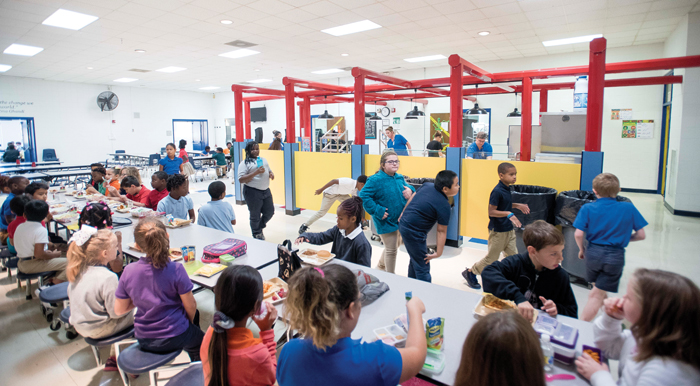For now, Rowan-Salisbury Schools lunch debt paid off
Published 12:00 am Sunday, December 22, 2019

- JON C. LAKEY / SALISBURY POST The cafeteria at Isenberg Elementary school is a busy place between 10 am and noon as students take a break from class and eat a meal.
SALISBURY — Because of community donors, Rowan-Salisbury Schools will enter the second half of the 2019-2020 school year with zero lunch debt for students.
Last week, donors paid off roughly $9,500 in lunch debt across the district after being inspired by the generosity of Brian Gilbert, who gave $400 to North Rowan High School two weeks earlier this month.
Philanthropist Fred Stanback was among those donors and said he offered money to help pay student lunch debt after reading Gilbert’s story in the Dec. 15 edition of the Post. Superintendent Lynn Moody said she received several inquiries from people after Gilbert’s donation, too, with all debt being paid off on Tuesday.
“We have churches, private citizens and groups, and some don’t want to be recognized, but they just show up and say, ‘We’re here for any student that needs help,’ ” said Lisa Altmann, RSS Nutrition Services director.
But last week’s good news doesn’t end the issue of student lunch debt, Altmann said.
The total lunch debt for the 2018-2019 school year was $9,700, Altmann said, and it rose as high as $12,000 during the first half of the year.
“So far, it’s been the highest I’ve seen,” said Altmann, a 19-year employee of Rowan-Salisbury Schools.
A few factors may be contributing to that, she said.
Naturally, school lunch debt is accrued when students don’t have the money to pay for their meal. But RSS doesn’t prevent students from eating if he or she doesn’t have the money. School staff charge the cost of the lunch to the student’s account. Any student unable to pay cannot get back in line and get a second lunch.
A number of schools in the district provide free breakfast and lunch to all students — Hurley, Overton, Hanford-Dole, Koontz, Isenberg, Landis and North elementary schools; Knox and North middle schools; and Henderson Independent. Students elsewhere in the district need to meet eligibility guidelines to receive free or reduced-price breakfast or lunch.
Children in households eligible for the Supplemental Nutrition Assistance Program (food stamps) or who receive cash assistance automatically qualify. Income eligibility guidelines determine who qualifies in other cases.
A family of four, for example, must take home less than $33,475 per year, or $1,288 every two weeks, to qualify for free meals during the 2019-2020 school year. Notably, that’s higher than the prior year, when a family of four needed to earn less than $32,630 per year, or $1,255 every two weeks.
The guidelines are nationwide rather than tailored to Rowan County or North Carolina, something Altmann sees as a recurring problem.
“Our cost of living may be different, but the guidelines are the same,” she said.
This year, Altmann said, 60.5% of students are eligible for free or reduced-price lunch. That’s compared to 65% one year earlier. But a lower percentage doesn’t mean more families are able to pay.
She said families may only be slightly above income guidelines but still have trouble paying to their child’s lunches, Altmann said. If a parent in the household receives a raise or promotion at work, it might mean the child is no longer eligible for free or reduced-price lunch but the family is only marginally better off. And with the new expense of school lunches, may end up worse off.
“It’s like a double-edged sword,” she said.
Students who were eligible for free or reduced-price lunch in the prior year have 30 days to return an updated application. Debt often starts accusing on the 31st day, she said.
While debt has now been cleared, it will begin accruing again when students return in early January. Altmann said parents, churches and groups interested in donating to a specific school call and ask for its nutrition manager.



